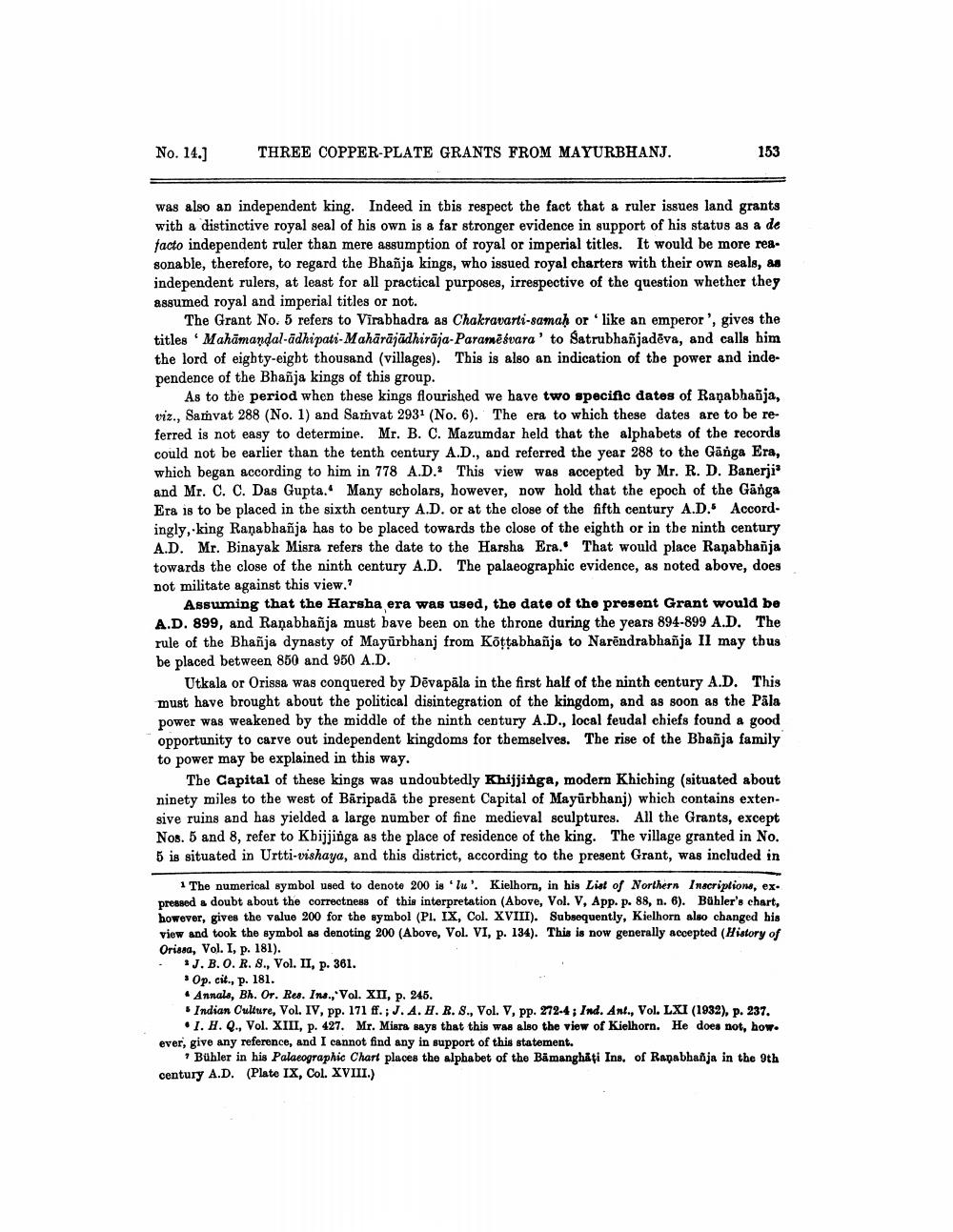________________
No. 14.]
THREE COPPER-PLATE GRANTS FROM MAYURBHANJ.
153
was also an independent king. Indeed in this respect the fact that a ruler issues land grants with a distinctive royal seal of his own is a far stronger evidence in support of his status as a de facto independent ruler than mere assumption of royal or imperial titles. It would be more reasonable, therefore, to regard the Bhañja kings, who issued royal charters with their own seals, as independent rulers, at least for all practical purposes, irrespective of the question whether they assumed royal and imperial titles or not.
The Grant No. 5 refers to Virabhadra as Chakravarti-samaḥ or like an emperor', gives the titles 'Mahamandal-adhipati-Mahārājādhirāja-Paramësvara' to Satrubhañjadēva, and calls him the lord of eighty-eight thousand (villages). This is also an indication of the power and independence of the Bhañja kings of this group.
As to the period when these kings flourished we have two specific dates of Raņabhaõja, viz.. Samvat 288 (No. 1) and Samvat 2931 (No. 6). The era to which these dates are to be referred is not easy to determine. Mr. B. C. Mazumdar held that the alphabets of the records could not be earlier than the tenth century A.D., and referred the year 288 to the Gānga Era, which began according to him in 778 A.D. This view was accepted by Mr. R. D. Banerji and Mr. C. C. Das Gupta. Many scholars, however, now hold that the epoch of the Ganga Era is to be placed in the sixth century A.D. or at the close of the fifth century A.D. Accordingly, king Ranabhañja has to be placed towards the close of the eighth or in the ninth century A.D. Mr. Binayak Misra refers the date to the Harsha Era. That would place Ranabhanja towards the close of the ninth century A.D. The palaeographic evidence, as noted above, does not militate against this view.?
Assuming that the Harsha era was used, the date of the present Grant would be A.D. 899, and Ranabhañja must have been on the throne during the years 894-899 A.D. The rule of the Bhañja dynasty of Mayūrbhanj from Kottabhañja to Narēndrabhañja Il may thus be placed between 850 and 950 A.D.
Utkala or Orissa was conquered by Dēvapāla in the first half of the ninth century A.D. This must have brought about the political disintegration of the kingdom, and as soon as the Pala power was weakened by the middle of the ninth century A.D., local feudal chiefs found a good opportunity to carve out independent kingdoms for themselves. The rise of the Bhañja family to power may be explained in this way.
The Capital of these kings was undoubtedly Khijjinga, modern Khiching (situated about ninety miles to the west of Bāripada the present Capital of Mayürbhanj) which contains exten. sive ruins and has yielded a large number of fine medieval sculptures. All the Grants, except Nos, 5 and 8, refer to Khijjinga as the place of residence of the king. The village granted in No. 5 is situated in Urtti-vishaya, and this district, according to the present Grant, was included in
1 The numerical symbol used to denote 200 is 'lu'. Kielhorn, in his List of Northern Inscriptions, expressed a doubt about the correctness of this interpretation (Above, Vol. V, App. p. 88, n. 6). Bühler's chart, however, gives the value 200 for the symbol (PI. IX, Col. XVIII). Subsequently, Kielhorn also changed his view and took the symbol as denoting 200 (Above, Vol. VI, p. 134). This is now generally accepted (History of Orissa, Vol. I, p. 181).
* J. B.O.R. 8., Vol. II, p. 361. • Op. cit., p. 181.
Annals, Bh. Or. Res. Ins., "Vol. XII, p. 245. * Indian Culture, Vol. IV, pp. 171 ff.; J. A. H. R. 8., Vol. V, pp. 272-4; Ind. Ant., Vol. LXI (1932), p. 237.
. 1. H. Q., Vol. XIII, p. 427. Mr. Misra says that this was also the view of Kielhorn. He does not, how ever, give any reference, and I cannot find any in support of this statement.
Bühler in his Palaeographic Chart places the alphabet of the Bämanghấti Ins, of Rapabhanja in the 9th century A.D. (Plate IX, Col. XVIII.)




